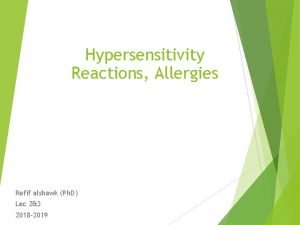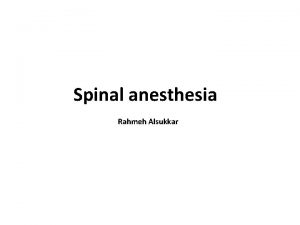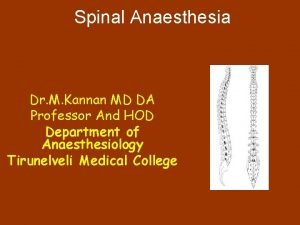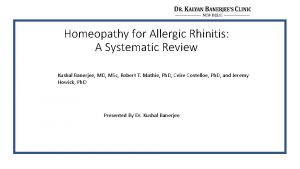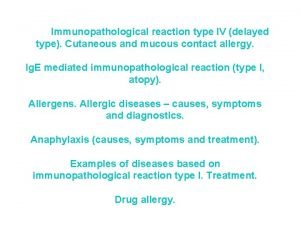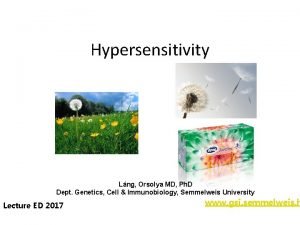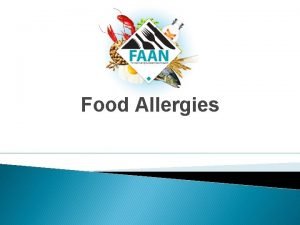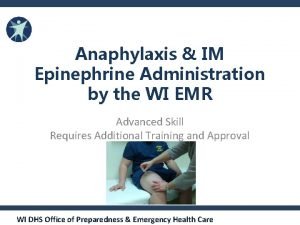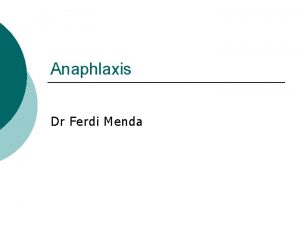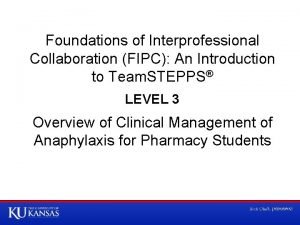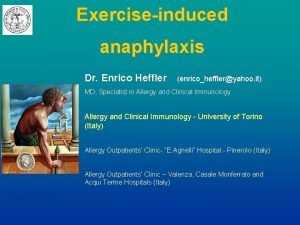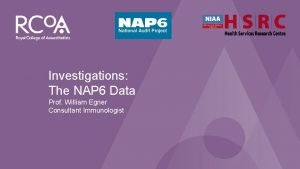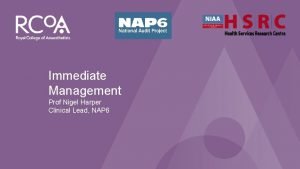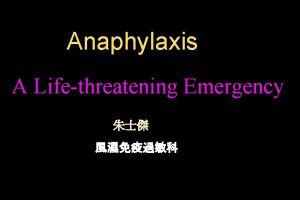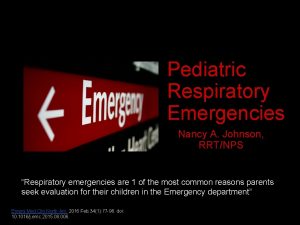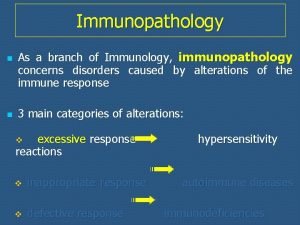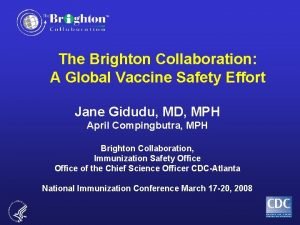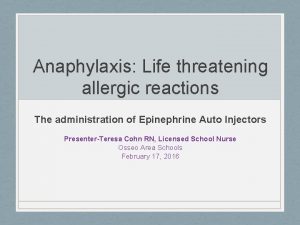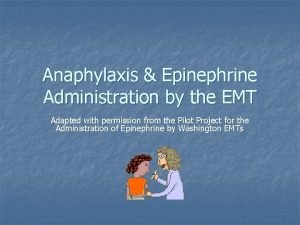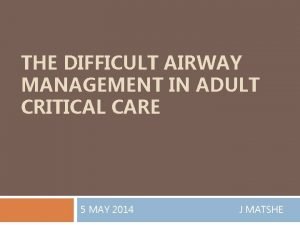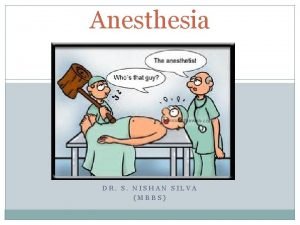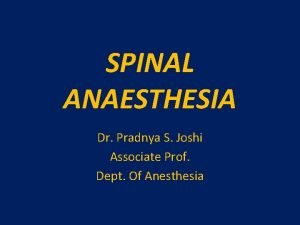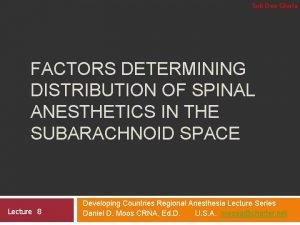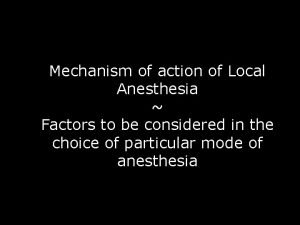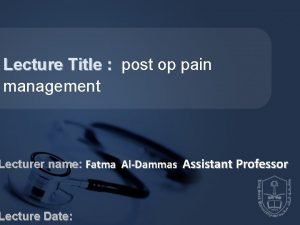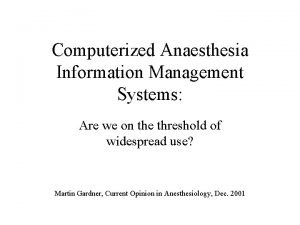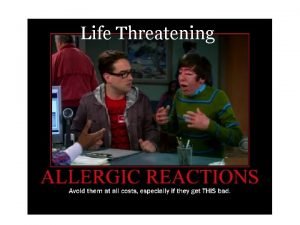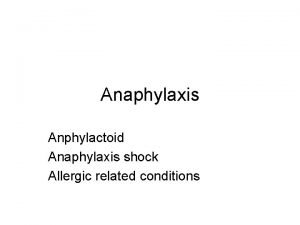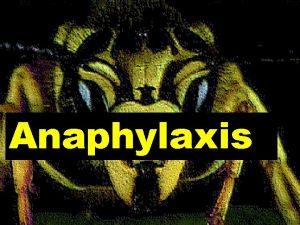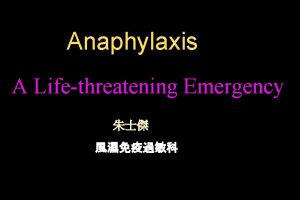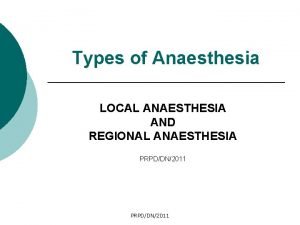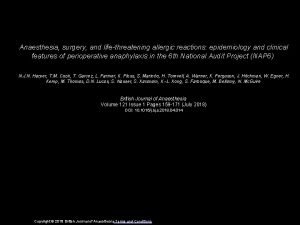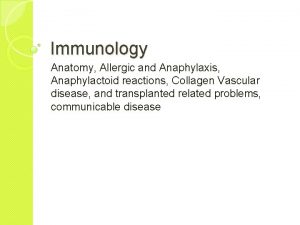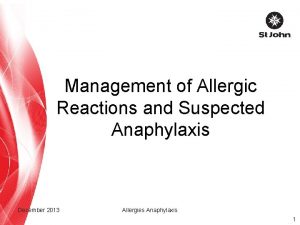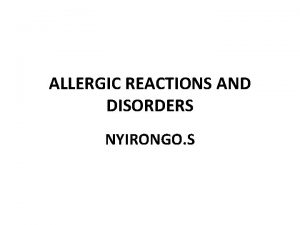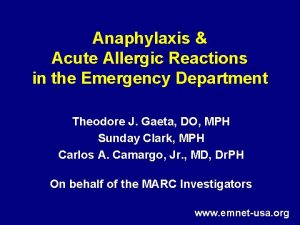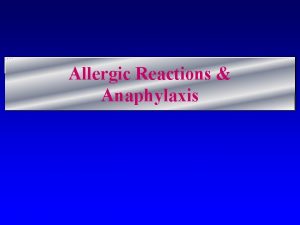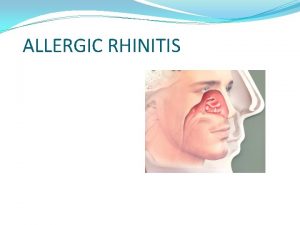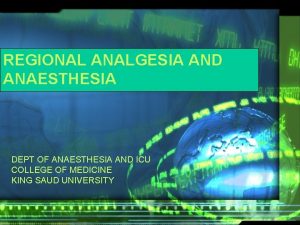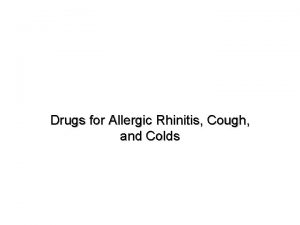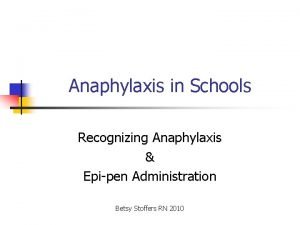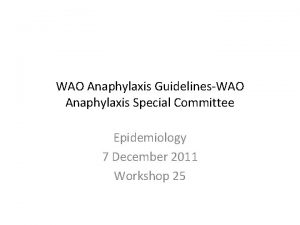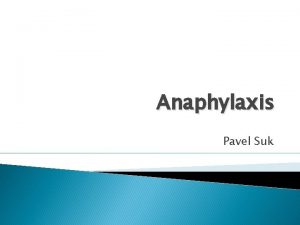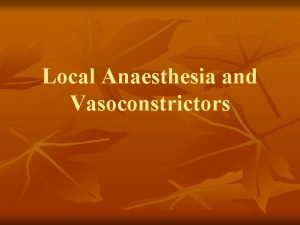Review Article ALLERGIC REACTIONS AND ANAPHYLAXIS DURING ANAESTHESIA











































- Slides: 43

Review Article ALLERGIC REACTIONS AND ANAPHYLAXIS DURING ANAESTHESIA JM Dippenaar | MBCh. B, DA(SA), MMed (Anes)1 S Naidoo | MBCh. B, MMed (Anes)2 1. Principal Specialist Anaesthesiology, Department of Maxillo Facial Oral Surgery, Oral and Dental Hospital, University of Pretoria 2. Specialist Anaesthesiology, Department of Anaesthesiology and Intensive Care, Kalafong Hospital, University of Pretoria Current Allergy & Clinical Immunology | March 2015 | Vol 28, No 1

INTRODUCTION Anaphylaxis during anaesthesia is a rare phenomenon, but may have life threatening consequences when encountered and if not managed correctly. Early signs and mild symptoms remain virtually unrecognised as, or when patients are unconscious and covered with surgical drapes, preventing observation of the initial skin manifestations.

INTRODUCTION Secondly, the severity of the reaction may be underestimated by the anaesthetist. The cardiovascular deterioration may initially be masked by a light plane of general anaesthesia (or an extensive regional block). Conversely, hypotension and difficulty in ventilation may have other more common causes that need to be excluded first.

INTRODUCTION Fourthly, allergenic agents are not limited to intravenous drugs or fluids, but include other substances used in the operating room such as skin disinfectants, latex gloves and catheters.

INTRODUCTION The worldwide reported rate of allergic reactions during anaesthesia is difficult to estimate, with quoted incidences of 1: 3500 (Canada), 1: 6000 (Norway), 1: 10000 to 1: 20000 (Australia) and 1: 34000 (single centre, USA) Allergies to every drug used in anaesthesia (except the volatiles) have been documented, with muscle relaxants and antibiotics alternating as leading

PATHOPHYSIOLOGY Anaphylaxis is an immediate immunologically mediated severe allergic reaction to an administered substance. Classified as a type I hypersensitivity reaction, it is now recognised that the reaction may be Ig. E-mediated or non Ig. Emediated.

PATHOPHYSIOLOGY Initial sensitisation occurs when the T lymphocytes in susceptible patients are presented with an allergen, and in response produce Ig. E antibodies. The Ig. E antibodies bind to high affinity FcεRI receptors on mast cells and basophils, and to low affinity FcεRII receptors of leucocytes, platelets and eosinphils.

PATHOPHYSIOLOGY Re-exposure to the same allergen results in multivalent cross-linking of the Ig. E antibodies bound to the high affinity receptors, activating intracellular transduction cascades with release of preformed mediators (histamine, tryptase, chymase, and heparin) from mast cells and basophils. A very small amount of antigen is required for this mechanism.

PATHOPHYSIOLOGY Histamine release may be idiopathic, it maybe triggered directly (with physical factors such as cold or heat, morphine and vancomycin), or may be released in response to bradykinin or complement activation.

PREVENTION AND DIAGNOSIS A careful and specific history of adverse or allergic drug reactions and subsequent avoidance of these drugs are the safest way to prevent peri-operative anaphylaxis. Female patients are three times more prone to allergies to latex and neuromuscular blocking agents (NMBAs) than males.

PREVENTION AND DIAGNOSIS Premedication with histamine (H) 1 or 2 receptor antagonists or glucocorticoids are not advantageous, as it rarely prevents the reaction and may blunt the initial onset and delay diagnosis. These drugs should be reserved for early treatment of the anaphylactic event

PREVENTION AND DIAGNOSIS The initial diagnosis of anaphylaxis relies on clinical grounds. The increase in serum tryptase is considered a fairly reliable indicator of mast cell degranulation, not of an anaphylactic reaction as such. Conversely, drugs that cause direct mast cell degranulation will increase tryptase levels.

Clinical criteria for diagnosing anaphylaxis Anaphylaxis is highly likely when any 1 of the following 3 criteria are fulfilled: � Acute onset of an illness (minutes to hours) � Occurrence of 2 or more of the following symptoms or signs after exposure to a likely allergen (minutes or hours) � Reduced BP after exposure to a known allergen (minutes to several hours) p: //bestpractice. bmj. com/best-practice/monograph/501/diagnosis/criteria. html Last updated: Aug 19, 20

Clinical criteria for diagnosing anaphylaxis Acute onset of an illness (minutes to hours) Involvement of skin, mucosal tissue, or both (i. e. , generalised hives, pruritus, or flushing, swollen lips-tongue-uvula) � and at least 1 of the following: � respiratory compromise (i. e. , dyspnoea, wheezebronchospasm, stridor, reduced peak expiratory flow [PEF], hypoxaemia) reduced BP or associated symptoms of end-organ dysfunction (i. e. , hypotonia/collapse, syncope, incontinence) p: //bestpractice. bmj. com/best-practice/monograph/501/diagnosis/criteria. html Last updated: Aug 19, 20

Clinical criteria for diagnosing anaphylaxis Occurrence of 2 or more of the following symptoms or signs after exposure to a likely allergen (minutes or hours) Involvement of skin, mucosal tissue, or both (i. e. , generalised hives, pruritus, or flushing, swollen lipstongue-uvula) � Respiratory compromise (i. e. , dyspnoea, wheezebronchospasm, stridor, reduced PEF, hypoxaemia) � Reduced BP or associated symptoms of end-organ dysfunction (i. e. , hypotonia/collapse, syncope, incontinence) � Persistent GI symptoms (i. e. , crampy abdominal pain, p: //bestpractice. bmj. com/best-practice/monograph/501/diagnosis/criteria. html Last updated: Aug 19, 20 vomiting) �

Clinical criteria for diagnosing anaphylaxis Reduced BP after exposure to a known allergen (minutes to several hours) � Systolic BP of <90 mm. Hg or >30% decrease from baseline. p: //bestpractice. bmj. com/best-practice/monograph/501/diagnosis/criteria. html Last updated: Aug 19, 20


SPECIFIC DRUGS NEURO MUSCULAR BLOCKING AGENTS ANTIBIOTICS LATEX LOCAL ANAESTHETICS OPIOIDS INDUCTION AGENTS VOLATILE AGENTS

NEURO MUSCULAR BLOCKING AGENTS The muscle relaxants as a group cause about 60% of immediate hypersensitivity reactions. The quaternary ammonium structure is the main contributing factor in development of allergic reactions. Although uneventful first exposure to an NMBA may cause sensitisation with type I reaction at next exposure.

NEURO MUSCULAR BLOCKING AGENTS Most cases of anaphylaxis are described with the use of succinylcholine. The inherent mobility of the molecular structure favours binding to Ig. E antibodies with subsequent reaction.

NEURO MUSCULAR BLOCKING AGENTS Rocuronium has a slightly less mobile structure, but may bind to Ig. E in similar fashion. Anecdotal evidence suggests that sugammadex, an alternative reversal agent for amino steroid non-depolarising NMBA’s may terminate the anaphylactic reaction as it chelates and removes the offending rocuronium molecules.

NEURO MUSCULAR BLOCKING AGENTS Benzylisoquinoliniums such as mivacurium and atracurium causes direct mast cell degranulation, when injected fast, causing a typical wheal and flare reaction. Cisatracurium, an isomer of atracurium, is not associated with histamine release

ANTIBIOTICS Penicillin is responsible for about 70% of anaphylactic reaction in the general population. Many texts still quote an 8 -10% cross reactivity for 1 st generation cephalosporins in penicillin allergy, possibly because they share a betalactam ring structure.

ANTIBIOTICS Current recommendation is that 2 nd and 3 rd generation cephalosporins may be cautiously administered to individuals with penicillin allergy, but not anaphylaxis, due to penicillin. Vancomycin, when administered over a short period of time is known to cause generalised histamine release – “Red Man Syndrome”. Anaphylaxis to other antibiotics is rare in

LATEX Latex is a natural rubber which is derived from the sap of Hevea brasilliensis. It causes about 20% of all anaphylactic reactions in the peri-operative period. The incidence seems to be decreasing as awareness and avoidance of latex during the peri-operative period becomes more frequent.

LATEX During anaesthesia there are several points of possible contact which can trigger a reaction including use of gloves by the healthcare provider, intravenous injection of drugs, even insertion of urine catheters and endotracheal tubes. Avoidance is the only effective treatment option at the moment.

LOCAL ANAESTHETICS Anaphylaxis due to local anaesthetics (LA) is exceedingly rare. Esters such as tetracaine and benzocaine are metabolised to para-amino-benzoic acid (PABA) which can provoke a type I Ig. E-mediated reaction. The preservatives methylparaben and metabisulphite, is the second most likely culprit in LA anaphylaxis.

LOCAL ANAESTHETICS There is no cross sensitisation between ester and amide groups of LA drugs. Systemic toxicity should always be considered when a patient presents with cardio-respiratory collapse after LA injection.

OPIOIDS True anaphylaxis has been reported with every opioid drug, but the incidence is extremely low. The tertiary amine structure of morphine, codeine and meperidine (Pethidine®) predisposes to mast cell degranulation with histamine release, with meperidine being the most common offender. Cross reactivity exists between opioids of the same group, except in the phenylpiperidine group (fentanyl, sufentanil, alfentanil,

INDUCTION AGENTS Propofol is responsible for 1. 2% to 2% of all peri-operative anaphylactic reactions. Current formulation in an emulsion of soy oil, egg albumin and glycerol (Intalipid®) may suggest cautious use in patients with egg or soy allergy, but there is no evidence to show increased risk of anaphylaxis in this population.

INDUCTION AGENTS The incidence of thiopentone allergy is 1: 30000, but since it is rarely used these days, reports of reactions to it are very rare too. Ketamine allergy is extremely rare, and etomidate is deemed the “most immunologically safe drug” in anaesthesia.

INDUCTION AGENTS Anaphylaxis to benzodiazepines (BZ) is extremely rare. Diazepam is dissolved in a propylene glycol base, making it more likely to cause anaphylaxis than midazolam. Midazolam has no metabolites, and is considered the immunologically safest BZ.

VOLATILE AGENTS There is not a single report of any anaphylactic reaction to any of the volatile agents. The rare fulminant form of hepatitis associated with halothane use is thought to have an immune component but is unrelated to anaphylaxis.

OTHER POTENTIAL PERI-OPERATIVE ALLERGENS Topical antiseptics such as povidoneiodine (betadine) andchlorhexidine have rarely been reported as allergens. Iodated contrast media may stimulate a reaction. Non-ionic media are prone to cause grade 1 (cutaneous manifestations) reactions, and pre-treatment with antihistamines and corticosteroids are effective in preventing these reactions.

OTHER POTENTIAL PERI-OPERATIVE ALLERGENS Colloids account for 2. 5% of all anaphylactic reactions intraoperatively. The incidence of allergic reactions is estimated to be 0. 06% for the hydroxylethyl starches, 0. 1% for albumin, 0. 26% for dextrans and 0. 34% for gelatins. Cross reactivity between the different colloids does not exist.

MANAGEMENT Once anaphylaxis is recognised, management consists of three distinct actions: I. II. III. withdrawal of the offending substance interrupting the effects of the preformed mediators released in response to antigen presentation prevention of further mediator release.

MANAGEMENT Immediate institution of basic life support measures (airway, breathing, circulation) and the early administration of adrenalin (epinephrine – α and β agonist) is the cornerstone of treatment. Endotracheal intubation with delivery of 100% oxygen via positive pressure ventilation is needed to compensate for increased oxygen consumption.

MANAGEMENT Circulatory support includes administration of large volumes of intravenous fluids (2 -4 L of crystalloids) to counteract the loss of intravascular volume due to capillary leakage. The α 1 effect counteracts hypotension by increased cardiac contractility and vasoconstriction, while the β 2 effect induces bronchodilation. Hypotension necessitates boluses adrenalin of 5 -10 μg (0. 2 μg/kg) as needed, but CVS collapse requires 0. 5 -1 mg (0. 2 mg/kg)


MANAGEMENT To counter the effects of released mediators, it is necessary to also administer H 1 (diphenhydramine) and H 2 (cimetidine, ranitidine) receptor antagonists. Persistent bronchospasm will necessitate the use of pure β 2 agonists (salbutamol).

MANAGEMENT Glucocorticoids have mast cell stabilising properties, are anti-inflammatory and therefore will prevent recurrence and minimise airway swelling. Hydrocortisone is the preferred corticosteroid because of its fast onset of action. Once the patient is stable the airway may be extubated. The patient will need close observation in

SUMMARY Although most drugs used in the perioperative period can cause anaphylaxis, it is fortunately a rare event. To identify the offending agent during the procedure is difficult. Muscle relaxants, latex and antibiotics are the most common anaesthetic allergens, and prevention is the most important component to decrease the risk. Post-operative referral to an allergist for identification of the causative allergen is

 Refifs
Refifs Spinal anesthesia ligaments
Spinal anesthesia ligaments Dizepam
Dizepam Dr. kushal banerjee
Dr. kushal banerjee Section 2 classifying chemical reactions worksheet answers
Section 2 classifying chemical reactions worksheet answers 10 examples of redox reaction
10 examples of redox reaction Section 2 reinforcement classifying chemical reactions
Section 2 reinforcement classifying chemical reactions Chemical reactions section 3 reactions in aqueous solutions
Chemical reactions section 3 reactions in aqueous solutions Unit 5 chemical reactions answers
Unit 5 chemical reactions answers Causes of anaphylactic reaction
Causes of anaphylactic reaction Alfametildopa
Alfametildopa Erythroblastosis
Erythroblastosis Anaphylaxis onset
Anaphylaxis onset How to draw up epinephrine
How to draw up epinephrine Anaphlaxis
Anaphlaxis Anaphylaxis classification
Anaphylaxis classification Interprofessional care for anaphylaxis
Interprofessional care for anaphylaxis Anaphylaxis
Anaphylaxis Nap anaphylaxis
Nap anaphylaxis Anaphylaxis treatment
Anaphylaxis treatment Anaphylaxis treatment
Anaphylaxis treatment Epiglotitis
Epiglotitis Anaphylaxis images
Anaphylaxis images Brighton collaboration levels
Brighton collaboration levels Sjs
Sjs Anaphylaxis photos
Anaphylaxis photos Anaphylaxis ig
Anaphylaxis ig How to draw up epinephrine for anaphylaxis
How to draw up epinephrine for anaphylaxis Lemon moans airway
Lemon moans airway Anesthesia airway anatomy
Anesthesia airway anatomy Structure pierced in spinal anesthesia
Structure pierced in spinal anesthesia Barbiturates moa
Barbiturates moa What is anesthesia
What is anesthesia Dr pradnya joshi
Dr pradnya joshi Contraindications of spinal anaesthesia
Contraindications of spinal anaesthesia Composition of local anesthesia
Composition of local anesthesia Lidocaine dose calculator
Lidocaine dose calculator Epidural space
Epidural space Balanced anaesthesia ppt
Balanced anaesthesia ppt Anaesthesia information management system
Anaesthesia information management system Chapter 8 review chemical equations and reactions
Chapter 8 review chemical equations and reactions Chemical equations and reactions chapter 8
Chemical equations and reactions chapter 8 Catarahh
Catarahh Wolowitz allergic reaction
Wolowitz allergic reaction
